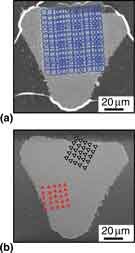Article contents
The effect of magnesium substitution on the hardness of synthetic and biogenic calcite
Published online by Cambridge University Press: 07 September 2012
Abstract

Biogenic minerals often contain inorganic and organic impurities that are believed to harden and toughen the material. However, because of the complexity of these systems, it is difficult to deconvolute the effect of each of these impurities on the hardness of the material. We have created single-crystal samples with a range of magnesium concentrations and measured their hardness while controlling for orientation. We find that hardness increases linearly with magnesium content and that magnesium impurities could account for ~20% of the increased hardness in biogenic calcite from the mollusk Atrina rigida when compared with pure geologic calcite.
Information
- Type
- Research Letters
- Information
- Copyright
- Copyright © Materials Research Society 2012
References
1.Meyers, M.A., Chen, P.-Y., Lin, A.Y.-M., and Seki, Y.: Biological materials: structure and mechanical properties. Prog. Mater. Sci. 53, 1 (2008).Google Scholar
2.Ma, Y.R., Cohen, S.R., Addadi, L., and Weiner, S.: Sea urchin tooth design: an “all-calcite” polycrystalline reinforced fiber composite for grinding rocks. Adv. Mater. 20, 1555 (2008).Google Scholar
3.Wang, R.Z., Addadi, L., and Weiner, S.: Design strategies of sea urchin teeth: structure, composition and micromechanical relations to function. Philos. Trans. R. Soc. Lond. B 352, 469 (1997).CrossRefGoogle ScholarPubMed
4.Kunitake, M.E., Mangano, L.M., Peloquin, J.M., Baker, S.P., and Estroff, L.A.: Evaluation of strengthening mechanisms in calcite single crystals from mollusk shells. Acta Biomater. (2012, submitted).Google Scholar
5.Moureaux, C., Pérez-Huerta, A., Compère, P., Zhu, W., Leloup, T., Cusack, M., and Dubois, P.: Structure, composition and mechanical relations to function in sea urchin spine. J. Struct. Biol. 170, 41 (2010).Google Scholar
6.Perez-Huerta, A., Cusack, M., and Zhu, W.: Assessment of crystallographic influence on material properties of calcite brachiopods. Mineral. Mag. 72, 563 (2008).CrossRefGoogle Scholar
7.Pérez-Huerta, A., Cusack, M., Zhu, W., England, J., and Hughes, J.: Material properties of brachiopod shell ultrastructure by nanoindentation. J. R. Soc. Interface 4, 33 (2007).CrossRefGoogle ScholarPubMed
8.Griesshaber, E., Schmahl, W.W., Neuser, R., Pettke, T., Blum, M., Mutterlose, J., and Brand, U.: Crystallographic texture and microstructure of terebratulide brachiopod shell calcite: an optimized materials design with hierarchical architecture. Am. Mineral. 92, 722 (2007).Google Scholar
9.Aizenberg, J. and Hendler, G.: Designing efficient microlens arrays: lessons from Nature. J. Mater. Chem. 14, 2066 (2004).CrossRefGoogle Scholar
10.Merkel, C., Deuschle, J., Griesshaber, E., Enders, S., Steinhauser, E., Hochleitner, R., Brand, U., and Schmahl, W.W.: Mechanical properties of modern calcite (Mergerlia truncata) and phosphate-shelled brachiopods (Discradisca stella and Lingula anatina) determined by nanoindentation. J. Struct. Biol. 168, 396 (2009).CrossRefGoogle ScholarPubMed
11.Anovitz, L.M. and Essene, E.J.: Phase equilibria in the system CaCO3-MgCO3-FeCO3. J. Petrol. 28, 389 (1987).Google Scholar
12.Raz, S., Weiner, S., and Addadi, L.: Formation of high-magnesian calcites via an amorphous precursor phase: possible biological implications. Adv. Mater. 12, 38 (2000).Google Scholar
13.Li, H.Y. and Estroff, L.A.: Calcite growth in hydrogels: assessing the mechanism of polymer-network incorporation into single crystals. Adv. Mater. 21, 470 (2009).Google Scholar
14.Falini, G., Gazzano, M., and Ripamonti, A.: Magnesium calcite crystallization from water-alcohol mixtures. Chem. Commun. 9, 1037 (1996).Google Scholar
15.Oliver, W.C. and Pharr, G.M.: Measurement of hardness and elastic modulus by instrumented indentation: advances in understanding and refinements to methodology. J. Mater. Res. 19, 3 (2004).Google Scholar
16.Elstnerova, P., Friak, M., Fabritius, H.O., Lymperakis, L., Hickel, T., Petrov, M., Nikolov, S., Raabe, D., Ziegler, A., Hild, S., and Neugebauer, J.: Ab initio study of thermodynamic, structural, and elastic properties of Mg-substituted crystalline calcite. Acta Biomater. 6, 4506 (2010).Google Scholar
17.Pokroy, B., Fitch, A.N., Marin, F., Kapon, M., Adir, N., and Zolotoyabko, E.: Anisotropic lattice distortions in biogenic calcite induced by intra-crystalline organic molecules. J. Struct. Biol. 155, 96 (2006).CrossRefGoogle ScholarPubMed
18.Stashans, A. and Chamba, G.: A new insight on the role of Mg in calcite. Int. J. Quantum Chem. 111, 2436 (2011).CrossRefGoogle Scholar
19.Tsipursky, S.J. and Buseck, P.R.: Structure of magnesian calcite from sea urchins. Am. Mineral. 78, 775 (1993).Google Scholar
20.Barber, D.J., Reeder, R.J., and Smith, D.J.: A TEM microstructural study of dolomite with curved faces (saddle dolomite). Contrib. Mineral. Petrol. 91, 82 (1985).CrossRefGoogle Scholar
21.Davis, K.J., Dove, P.M., Wasylenki, L.E., and De Yoreo, J.J.: Morphological consequences of differential Mg2+ incorporation at structurally distinct steps on calcite. Am. Mineral. 89, 714 (2004).Google Scholar
22.Paquette, J. and Reeder, R.J.: Relationship between surface structure, growth mechanism, and trace element incorporation in calcite. Geochim. Cosmochim. Acta 59, 735 (1995).Google Scholar
24.Evans, A.G. and Langdon, T.G.: Structural ceramics. Prog. Mater. Sci. 21, 171 (1976).CrossRefGoogle Scholar
25.Long, X., Nasse, M.J., Ma, Y., and Qi, L.: From synthetic to biogenic Mg-containing calcites: a comparative study using FTIR microspectroscopy. Phys. Chem. Chem. Phys. 14, 2255 (2012).CrossRefGoogle ScholarPubMed
26.Long, X., Ma, Y., and Qi, L.: In vitro synthesis of high Mg calcite under ambient conditions and its implication for biomineralization process. Cryst. Growth Des. 11, 2866 (2011).Google Scholar
- 70
- Cited by

